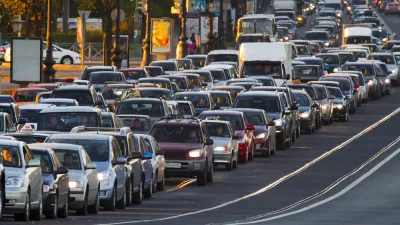New data released by the Federal Highway Administration shows that vehicle mile traveled increased three percent for the first nine months of 2016 compared to the same period last year. Driving has increased continuously since April 2014.

"The new data, published in FHWA’s latest 'Traffic Volume Trends' report – a monthly estimate of U.S. road travel — show that more than 265.5 billion miles were driven in September 2016 alone which is a 2.9 percent increase over the previous September," reports Doug Hecox for the Federal Highway Administration.
When seasonally-adjusted ("which is conducted by USDOT’s Bureau of Transportation Statistics as a way to even out seasonal variation in travel and enable vehicle miles travelled comparisons with any other month in any year"), the September increase drops to 2.4 percent. The adjusted increase over August 2016 was .4 percent.
The September 2016 Traffic Volume Trends report includes a map and chart showing the changes by regions. All five regions saw increases, with the West experiencing the largest at 5.5 percent, and the North-East and North-Central increasing the least, at 1.7 percent and 1.6 percent, respectively.
Vehicle miles travel increase and population growth
Planning agencies might set a goal of keeping VMT increase to a percentage of population growth, bearing in mind that the population would need to be adjusted for those who are at least 16 years of age. The American Public Transit Association points out in a 2009 report [PDF] that "from 1970 to 2007, VMT grew by 168 percent while population only grew by 48 percent," or 3.5 times as fast. That's slower than the first nine months of the year: VMT grew almost four times faster than total (unadjusted) population growth (about .77 percent).
Ideally metropolitan regions could replicate the smart growth policies enacted by Vancouver, B.C., which increased population while reducing traffic, as noted by Streetsblog USA's Angie Schmitt in 2013.
See the Planetizen post on driving totals for the first six months of 2016, which had increased 3.3 percent. A March post and blog indicate that 2015 broke what was thought to be "peak driving" record set in 2007. A January 2015 post noted that the increase in VMT in 2014.
FULL STORY: U.S. Drivers Log 2.4 Trillion Miles In First Nine Months of 2016

Alabama: Trump Terminates Settlements for Black Communities Harmed By Raw Sewage
Trump deemed the landmark civil rights agreement “illegal DEI and environmental justice policy.”

Study: Maui’s Plan to Convert Vacation Rentals to Long-Term Housing Could Cause Nearly $1 Billion Economic Loss
The plan would reduce visitor accommodation by 25% resulting in 1,900 jobs lost.

Planetizen Federal Action Tracker
A weekly monitor of how Trump’s orders and actions are impacting planners and planning in America.

Wind Energy on the Rise Despite Federal Policy Reversal
The Trump administration is revoking federal support for renewable energy, but demand for new projects continues unabated.

Passengers Flock to Caltrain After Electrification
The new electric trains are running faster and more reliably, leading to strong ridership growth on the Bay Area rail system.

Texas Churches Rally Behind ‘Yes in God’s Back Yard’ Legislation
Religious leaders want the state to reduce zoning regulations to streamline leasing church-owned land to housing developers.
Urban Design for Planners 1: Software Tools
This six-course series explores essential urban design concepts using open source software and equips planners with the tools they need to participate fully in the urban design process.
Planning for Universal Design
Learn the tools for implementing Universal Design in planning regulations.
Caltrans
Smith Gee Studio
Institute for Housing and Urban Development Studies (IHS)
City of Grandview
Harvard GSD Executive Education
Toledo-Lucas County Plan Commissions
Salt Lake City
NYU Wagner Graduate School of Public Service





























